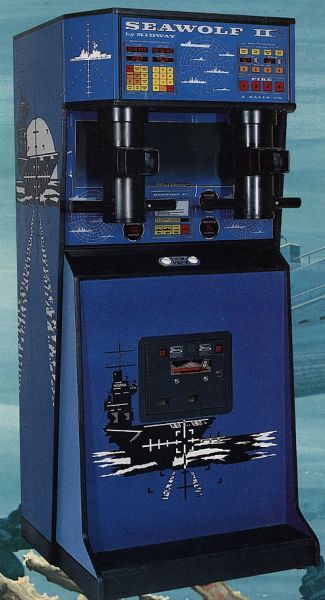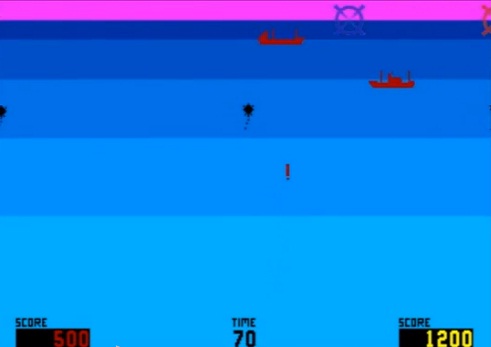
At this stage in early video game history, technology moved at a lightning fast pace. Each new game that was released brought some new innovation, like the microprocessor, force feedback, or vector graphics. Seawolf II, released just two years after the original, included one such new technology: a color display. No longer was a color film overlay needed; several different blue hues gave the playfield a sense of depth. Red and yellow boats stood out nicely for targeting.
Like Periscope and the first Seawolf, Seawolf II had a visually appealing cabinet. Since the graphics of early video games weren't exactly immersive, the art style of the cabinet was very important. Anything that would add to the experience kept players engaged, and thus spending more money. Seawolf II had a rich blue color scheme, with a depiction of aircraft carrier, lined up perfectly in targeting sights, splashed across the sidepanels. Mock display screens, dials, and switches on the marquee and bezel helped create the illusion of actually being inside a submarine.
Even with the color display, and the clever cabinet design, Seawolf II’s greatest innovation was the addition of a second player. Two or even four player games weren’t unheard of; Pong variants had allowed more players for several years. But typically a multiplayer game was directly competitive. Players were on opposite teams, or shooting one another, or racing around a track in furious competition. Seawolf II allowed two players to work against a common enemy. Two separate periscopes allowed the undersea partners to shoot torpedoes independently of one another. Standing right next to a buddy, leaned over the periscope, shooting enemy boats down together, must have felt very cooperative indeed.

One might argue that the scoring, kept individually, made the game competitive. The enemy boats never fired back, though the minefield across midfield did add some challenge to the experience. Once the time limit was over, one player could have scored more than the other. In one sense, this is competitive, but not nearly as much as shooting your buddy in the face, or crossing the finish line first. While Seawolf II might not meet the strict definition of co-op we use for games today, we’ll certainly make an exception for a game from the infancy of the video game era.
Seawolf II might be the earliest co-op game in our database; the only other game from the 1978 list is Fire Truck, and I've been unable to discover which of the two came first. Either way, Seawolf II has a greater legacy, being a natural evolution of the periscope-based amusement game concept. Adding a second player to a game, without direct competition between the two, was a milestone in cooperative gaming. The next time you play Firefight, Horde, or some other survival mode with individual player scoring, think back to Seawolf II, where the concept began.